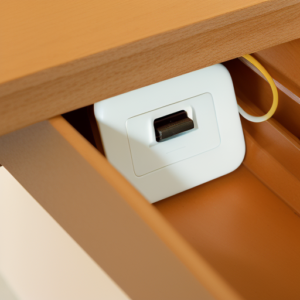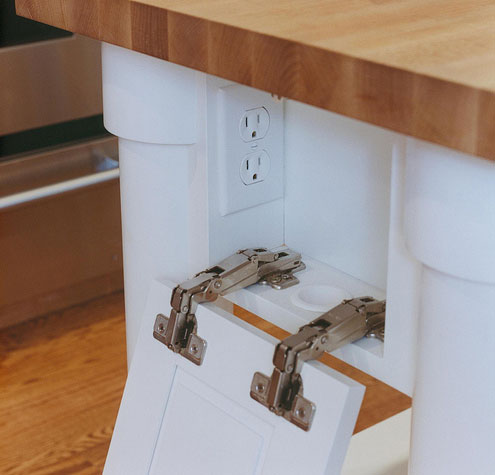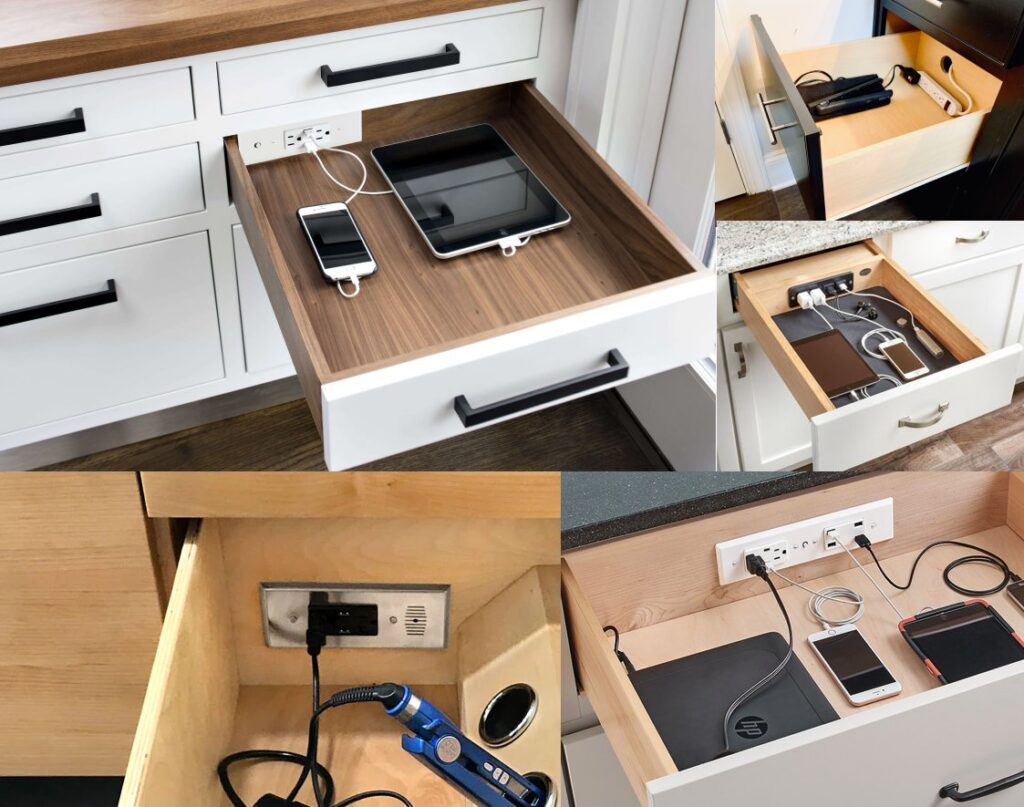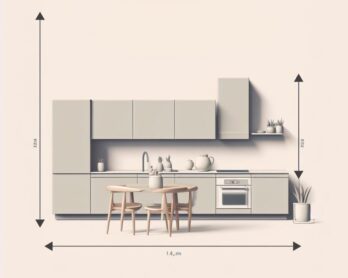Electrical outlet inside the drawer
Installing an electrical outlet within a drawer is an innovative solution that has become increasingly popular. This hidden power source offers numerous advantages to the homeowner, proving both practical and aesthetically pleasing.
This is a great tip if you’re designing a new kitchen or remodelling the old one. Having plenty of electrical outlets somewhere in a kitchen is always a good idea. And you probably keep some things that require charging in your drawers, such as a cellphone or mp3 player. Usually you have to take them out to charge them. So why not put a electrical outlet inside the drawer?
With this system you can charge your gadgets while they’re inside the drawer. It’s a great way to prevent clutter and keep your kitchen as clean and organized as possible.
Pros of an electrical outlet in a drawer
Reduced Clutter
One significant advantage of drawer-installed electrical outlets is the noticeable reduction of clutter. By concealing cords and charging devices within the drawer outlets, your countertops and living spaces remain mess-free and you can eliminate countertop clutter. This neat and tidy approach provides a clean and organized working area and allows you to focus on the task at hand.
Enhanced Safety
Safety is paramount when dealing with electricity. Installing an electrical outlet in a drawer ensures that cords remain out of sight, which helps prevent accidents such as tripping or knocking over devices. This design feature also reduces the risk of young children plugging and unplugging devices or mistakenly ingesting small electronics.
Space Optimization
Incorporating an electrical outlet within a drawer helps optimize your living space. You can easily charge your devices in an organized and convenient manner without dealing with cord tangles or cluttered countertops. This hidden power source allows for easy access while still maintaining a sleek, functional and modern look in your living or work area.

3 main Cons of an electrical outlet in a drawer
While electrical outlets in drawers offer many practical benefits, it is essential to consider the potential drawbacks. In this section, we’ll discuss three main cons associated with installing an electrical outlet in a drawer.
Installation Cost and Complexity
One notable downside to installing an electrical outlet in a drawer is the cost and complexity associated with the setup. This process may require hiring a professional electrician, which can be an additional expense compared to simply plug in to a standard wall outlet. Additionally, wiring a built-in power source within a drawer can be more complicated due to the confined space and power cord placement, which may lead to a higher installation cost.
Limited Space and Weight Capacity
Integrating an electrical outlet into a drawer has the potential to limit the overall storage space and weight capacity. Charging multiple devices simultaneously within the drawer may cause them to stack on top of each other, potentially leading to unwanted scratches or damage. Furthermore, electrical components can add weight to the drawer, possibly affecting the drawer’s ability to slide in and out smoothly. In some cases, you may need to install reinforced drawer slides to support the extra weight.
Potential for Overheating
As charging devices generate heat, storing them within a confined space like a drawer can elevate the risk of overheating. A poorly-ventilated space may cause the temperature to rise, affecting the performance and lifespan of both the devices and the electrical components within docking drawer outlets and the outlet. To mitigate this risk, it is vital to ensure adequate ventilation is provided for the drawer, either through a built-in ventilation design or by leaving the drawer slightly ajar during high-heat charging sessions.
Installing In-Drawer Outlets Is Now Easier Than Ever
Installing a hidden plug in your drawer is very easy. It’s so easy you can probably do it yourself. Wire a plug in the back of the drawer and connect it to a power outlet somewhere else in docking drawer. Don’t forget to make these cables long enough, otherwise you won’t be able to open your drawer completely.

Even in smaller compartments of your kitchen you can use this tip (check out the photo above). It can also be used in other rooms of the house. In a bathroom, for example, you can protect your power outlets from water splashes.
5 Installation Tips and Things to Watch Out for when Installing an Electrical Outlet in a Drawer
1. Choose the Right Location:
Carefully consider the most suitable location within your space, ensuring the drawer opening is near a power source and readily accessible for charging devices.
2. Hire a Professional:
To ensure the safe installation and proper functioning of the electrical outlet in drawer top, consider to engage a licensed electrician experienced in drawer outlet installations.
3. Select a Proper Outlet Type:
Research the various drawer-safe electrical outlets and outlet designs available and choose one that provides optimal safety features, such as GFCI protection or tamper resistance.
4. Ensure Adequate Ventilation:
To prevent overheating, guarantee that the drawer design includes sufficient ventilation, or consider leaving the drawer partially open during high-heat charging sessions.
5. Address Weight and Space Limitations:
When planning your installation project, consider reinforcing drawer slides to support the added weight and arranging the layout to maximize storage space efficiency.
Add power outlet in a drawer video overview
Let’s take some time to learn more about this procedure by watching the video below.
Conclusion
While an electrical outlet in a drawer offers various benefits, such as reduced clutter and improved device security, it is crucial to consider some possible cons that may arise. Understanding the potential pitfalls will enable an informed decision, helping you choose and create an electrical solution that best suits your needs and lifestyle.
Questions & Answers
Can you put an outlet in a drawer?
Yes, you can put an outlet in a drawer, providing a convenient and concealed power source for charging devices and reducing clutter on countertops.
How do you make an electrical outlet in a drawer?
To create an electrical outlet in a drawer, you’ll need to select a suitable location, choose the right type of outlet, route the wiring to accommodate the drawer, and install the outlet using appropriate safety measures, preferably with the help of a professional electrician.
Can you put an outlet in a bathroom drawer?
You can put an outlet in a bathroom drawer, but it is crucial to use a Ground Fault Circuit Interrupter (GFCI) outlet and follow local electrical code requirements for electrical installations in wet areas due to the increased risk of water contact.
What is a docking drawer?
A docking drawer is a specialized built-in drawer that contains an integrated electrical outlet, offering a streamlined solution for charging devices and accessories and powering small appliances while keeping cords and clutter hidden from view.









